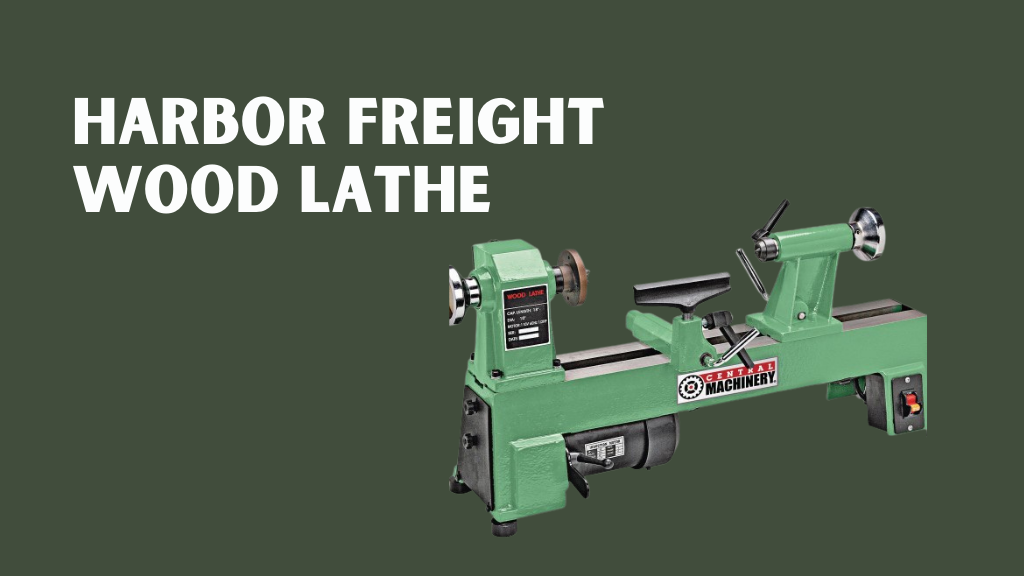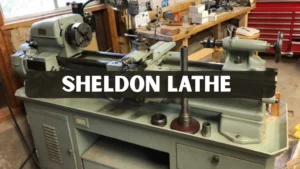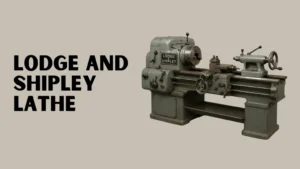Woodturning is one of the most creative and rewarding crafts, allowing you to transform raw blocks of wood into functional or decorative pieces. From bowls and pens to chair legs and ornaments, the possibilities are endless. At the heart of this craft lies the wood lathe, a machine designed to rotate wood while you shape it with cutting tools. Among the budget-friendly options available in the U.S., the Harbor Freight wood lathe has earned a reputation for being affordable and beginner-friendly.
Harbor Freight Tools, a retailer well-known for offering inexpensive tools across the U.S. and online, sells its wood lathes under the Central Machinery brand. While not considered professional-grade, these lathes make woodturning accessible to beginners and hobbyists who don’t want to spend thousands of dollars. This comprehensive guide explores Harbor Freight wood lathes in detail, covering models, specifications, pros and cons, accessories, real-world reviews, buying advice, and frequently asked questions.
What Is a Harbor Freight Wood Lathe?
A wood lathe is a specialized woodworking machine that securely holds and spins a piece of wood, allowing the user to cut, shape, sand, or polish it into a smooth and refined form. Among the many options available on the market, the Harbor Freight wood lathe, sold under the Central Machinery brand, is known for making woodturning tools accessible to hobbyists and beginners at a fraction of the cost of professional-grade equipment.
-
Affordability
Harbor Freight wood lathes are priced significantly lower than premium brands, making them an attractive entry point for newcomers who want to experiment with woodturning without committing to a major investment.
-
Accessibility
With more than 1,000 retail stores across the United States and a convenient online shopping platform, Harbor Freight ensures that its tools are easy to find and purchase, whether in person or from home.
-
Beginner-Friendly
Designed with simplicity in mind, these lathes are relatively easy to assemble, operate, and maintain, making them a practical choice for woodshop teachers, hobbyists, and students.
Because of their affordability and straightforward design, Harbor Freight wood lathes are often chosen by entry-level woodworkers, hobbyists, and educators who want to explore the art of woodturning without investing in high-end machinery.
Harbor Freight Wood Lathe Models and Specifications
Harbor Freight offers a range of wood lathes under its Central Machinery line. These models are designed to meet the needs of beginners and hobbyists who want affordable tools for woodworking projects.
1. Central Machinery 12″ x 33-3/8″ Wood Lathe
This is Harbor Freight’s flagship lathe and one of the most popular budget lathes in the U.S.
- Swing over bed: 12 inches
- Distance between centers: 33-3/8 inches
- Motor power: 3/4 HP, 110V
- Speed range: 600, 1100, 1600, 2200, and 2400 RPM
- Weight: Around 100 lbs
- Construction: Cast iron frame for stability
This model is ideal for small to medium projects, such as chair legs, spindles, and small bowls. Its five-speed settings provide enough versatility for beginner projects.
2. Harbor Freight Mini Wood Lathes
Harbor Freight also sells smaller mini-lathes designed for compact workshops and lightweight projects:
- Best for: Pens, ornaments, miniature bowls, and small decorative items.
- Features: Lightweight, portable, and easy to use.
While these models lack power compared to the 12″ x 33-3/8″ lathe, they are an excellent choice for those just experimenting with woodturning.
Pros and Cons of Harbor Freight Wood Lathe
Like any tool, Harbor Freight wood lathes come with both advantages and limitations. Understanding these pros and cons can help you decide whether they are the right fit for your woodworking needs.
Pros
- Budget-Friendly: Priced significantly lower than Jet, Delta, or Nova models.
- Entry-Level Friendly: Easy to assemble and learn on.
- Available Nationwide: Accessible in-store and online.
- Versatile: Suitable for turning spindles, pens, and small bowls.
Cons
- Less Powerful: Motors are smaller compared to higher-end models.
- Durability Issues: Heavy-duty users may experience motor wear or vibration over time.
- Precision: Not as precise as premium lathes.
- Limited Speed Adjustability: Most models use step pulleys instead of variable speed dials.
- Upgrades Required: Many users buy aftermarket tool rests, chucks, and centers for better performance.
Real-World Experiences with Harbor Freight Wood Lathe
Harbor Freight wood lathes have received mixed but generally positive reviews from users. Many beginners and hobbyists report that these lathes provided an affordable and approachable way to get started with woodturning.
Hobbyist Experience
A woodworking hobbyist from Ohio shared that his Central Machinery 12″ x 33-3/8″ lathe lasted over six years of weekly use. To improve performance, he upgraded the tool rest and tailstock, which resulted in smoother operation and better project results.
Educational Use
A high school woodworking instructor used Harbor Freight lathes for his woodshop classes. He praised them for being budget-friendly while still offering enough functionality to teach students the fundamentals of woodturning.
Professional Perspective
A professional woodturner compared a Harbor Freight lathe with his higher-end Jet lathe. Although he noted that the Harbor Freight model was less precise, he acknowledged that it was “surprisingly good for the price” and suitable for hobbyists or casual woodworkers.
How to Use a Harbor Freight Wood Lathe
Using a Harbor Freight wood lathe safely and effectively requires proper setup, safety precautions, and choosing the right beginner projects.
Setting Up the Lathe
- Stable Surface: Place the lathe on a sturdy, level workbench or surface.
- Secure the Lathe: Bolt it down to minimize vibration during operation.
- Check Alignment: Ensure proper alignment between the headstock and tailstock for accurate turning.
- Mount the Wood Blank: Use a spur center or faceplate to securely hold the workpiece in place.
Safety Tips
- Wear Protective Gear: Always use safety goggles and a face shield.
- Dust Protection: Use a dust collection system or wear a dust mask to avoid inhaling wood particles.
- Avoid Loose Clothing: Keep sleeves rolled up and remove jewelry to prevent accidents.
- Adjustments: Never adjust the tool rest while the lathe is running.
- Tool Maintenance: Keep turning tools sharp for safe, smooth cuts.
Beginner Projects
- Spindles: Perfect for practicing cutting and shaping techniques.
- Bowls: The 12″ model can handle small to medium-sized bowls.
- Pens: Mini-lathes paired with a pen mandrel are excellent for starter projects.
- Ornaments: Create holiday decorations, small figurines, or decorative items.
Accessories for Harbor Freight Wood Lathe
To get the most out of a Harbor Freight wood lathe, many users invest in additional accessories. These tools enhance precision, expand the lathe’s capabilities, and make projects more enjoyable. Choosing the right accessories can also improve safety and efficiency for both beginners and hobbyists.
-
Lathe Chisels
Lathe chisel sets typically include gouges, skews, and parting tools. They allow for a variety of cutting, shaping, and detailing techniques. Using quality chisels ensures smoother cuts and reduces tear-out. Regular maintenance of chisels keeps them effective and safe to use.
-
Chucks
Chucks are essential for holding irregular or round workpieces securely. They provide better stability during turning, reducing wobble and mistakes. With a reliable chuck, even complex shapes can be managed efficiently. This makes chucks a valuable upgrade for many users.
-
Centers
Spur centers and live centers improve turning accuracy significantly. They reduce wobble and help keep the workpiece aligned between the headstock and tailstock. This is especially important for longer projects. Using quality centers results in cleaner, more precise finishes.
-
Sanding Attachments
Sanding attachments make finishing projects faster and smoother. They are particularly useful for bowls, spindles, and detailed items. With proper sanding tools, surfaces can achieve a professional-quality finish. These attachments save time compared to hand sanding alone.
-
Sharpening Systems
Sharpening systems help keep chisels and cutting tools razor-sharp. Sharp tools ensure safer and cleaner cuts, reducing effort during woodturning. Regular sharpening also extends the lifespan of your tools. Investing in a sharpening system improves both efficiency and quality.
-
Extension Beds
Extension beds increase the turning capacity of your lathe, allowing you to work on longer pieces. They are ideal for projects that exceed the standard bed length of the lathe. Always check compatibility before purchasing. Extension beds give hobbyists more flexibility for larger projects.
Alternatives to Harbor Freight Wood Lathe
If you are looking to invest in more professional-grade equipment, there are several popular alternatives. These lathes offer higher precision, smoother operation, and greater long-term durability. While they are more expensive, they are ideal for serious hobbyists or semi-professional woodturners.
-
Jet JWL-1221VS
The Jet JWL-1221VS features a variable speed range of 60 to 3600 RPM, allowing precise control for a variety of projects. Its build quality ensures excellent stability and accuracy. This lathe is ideal for both beginners ready to upgrade and experienced woodworkers. Prices typically range from $900 to $1000.
-
Delta 46-460
The Delta 46-460 comes with a 1 HP motor and reversible speed for versatile operation. It has a 12.5-inch swing over the bed and 16.5 inches between centers, making it suitable for medium-sized projects. This lathe generally costs around $800 to $900.
-
Nova Comet II
The Nova Comet II is compact and versatile, making it perfect for pen turning, small bowls, and decorative projects. It offers a variable speed range of 250–4000 RPM for precise control. Prices for this model range from $500 to $600.
Although these lathes are more expensive than Harbor Freight models, they provide greater precision, smoother operation, and long-term durability. For woodworkers planning frequent use or more advanced projects, these alternatives are a worthwhile investment.
Buying Guide: Should You Get a Harbor Freight Wood Lathe?
Choosing the right wood lathe depends on your budget, skill level, and the types of projects you plan to tackle. Harbor Freight lathes are an affordable and accessible option, especially for beginners and hobbyists. Understanding their strengths and limitations will help you make an informed decision.
-
Budget Considerations
If you are on a tight budget, Harbor Freight lathes are difficult to beat. They provide basic functionality at a fraction of the cost of professional models. For hobbyists, this makes it easy to start woodturning without a major financial commitment.
-
Skill Level
Harbor Freight lathes are best suited for beginners and hobbyists. Their straightforward assembly and simple operation allow new users to learn woodturning fundamentals quickly. More advanced users may find them limiting over time.
-
Project Size
These lathes are ideal for small to medium projects, such as pens, bowls, and spindles. They are not designed for large furniture-scale turning or heavy-duty tasks. Consider your long-term project goals before choosing this model.
-
Longevity and Upgrades
While Harbor Freight lathes are durable enough for casual use, many users eventually upgrade components or move to higher-end brands. As your skills and project demands grow, investing in a Jet, Delta, or Nova lathe may be worthwhile.
If you are just starting out in woodturning, a Harbor Freight lathe is an excellent entry point. It allows you to learn, experiment, and build confidence before committing to a professional-grade machine.
Harbor Freight Wood Lathe Reviews and Ratings
The Central Machinery 12″ x 33-3/8″ lathe is one of Harbor Freight’s most popular models. It averages around 4.3 stars from over 500 customer reviews on the Harbor Freight website. Users often praise its affordability and ease of use, while noting some limitations in power and precision.
Positive Feedback
Many users appreciate this lathe as an affordable entry-level option. Its sturdy cast-iron construction adds stability during turning projects. The lathe is capable of handling a variety of tasks, including spindles, small bowls, and pens. Overall, it provides excellent value for beginners and hobbyists.
Negative Feedback
Some users report that the motor can be underpowered for larger or heavier projects. Vibrations at higher speeds can affect smoothness and precision. Additionally, the step-pulley speed settings are more limited compared to variable-speed lathes, which may restrict certain advanced turning techniques.
Conclusion
The Harbor Freight wood lathe offers an affordable gateway into the world of woodturning. While it may not rival the precision and durability of Jet, Delta, or Nova lathes, it delivers solid value for its price. Beginners can learn the fundamentals, create beautiful projects, and later upgrade as their skills grow. For hobbyists and DIY woodworkers looking for a cost-effective entry point, Harbor Freight lathes are well worth considering.
FAQs
Is a Harbor Freight wood lathe good for beginners?
Yes. It’s affordable, easy to set up, and reliable for entry-level woodturning.
How long do Harbor Freight wood lathes last?
With proper care, they can last several years. Heavy daily use may shorten their lifespan compared to professional lathes.
Can you turn bowls on a Harbor Freight wood lathe?
Yes. The 12″ x 33-3/8″ model is suitable for small to medium bowls.
What upgrades are recommended?
A quality chuck, live center, and improved tool rest are the most common upgrades.
Is it worth buying used vs new?
Buying new ensures warranty coverage. Used models may be cheaper but could require part replacements.




